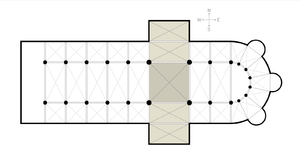Latin cross
A Latin cross or crux immissa is a type of cross in which the vertical beam sticks above the crossbeam,[1] with the three upper arms either equally long or with the vertical topmost arm shorter than the two horizontal arms, and always with a much longer bottom arm.[2]


If displayed upside down it is called St. Peter's Cross, because he was reputedly executed on this type of cross.[3] When displayed sideways it is called St. Philip's cross for the same reason.[3]
Use in the USA
In the USA, the Latin cross began as a Roman Catholic emblem, being vehemently contested as Satanic by various Protestant denominations in the 19th century, but has since become a universal symbol of Christianity and is now the main representation of the cross for Protestants, too.[4]
Cruciform churches
A Latin cross plan is a floor plan found in many churches and cathedrals.[5] When looked at from above or in plan view it takes the shape of a Latin cross (crux immissa).[6] Such cruciform churches were very common in the West during the Romanesque period.[2] The Latin cross plans have a nave with aisles or chapels, or both, and a transept that forms the arms of the cross.[6] It also has at least one apse that traditionally faces east. Many also have a narthex at the entry.[6]
In computer systems
The glyph has a unicode code point: U+271D ✝ LATIN CROSS (HTML ✝)
See also
- U+2628 ☨ CROSS OF LORRAINE
- U+2020 † DAGGER
- U+2021 ‡ DOUBLE DAGGER
See also
- Christian symbolism
- Christian cross
- Greek cross
References
- Herbert Norris, Church Vestments: Their Origin and Development (Mineola, NY: Dover Publications, 2002), p. 128
- Curl, James Stevens (2015). cross: Latin. Oxford Dictionary of Architecture and Landscape Architecture. Oxford University Press. p. 213. ISBN 978-0-19-860678-9. Retrieved 5 May 2020.
- Joyce Mori, Crosses of Many Cultures (Harrisburg, PA: Morehouse Publishing, 1998), p. 32
- Smith, Ryan K. (2006). Gothic Arches, Latin Crosses: Anti-Catholicism and American Church Designs in the Nineteenth Century. Chapel Hill, NC: University of North Carolina Press. pp. 54, 57. ISBN 978-0-8078-5689-5. Retrieved 5 May 2020.
- St. Peter's in the Vatican, ed. William Tronzo (Cambridge: Cambridge University Press, 2005), p. 275
- Lilian H. Zirpolo, Historical Dictionary of Baroque Art and Architecture (Lanham, MD: Scarecrow Press, 2010), p. 314
